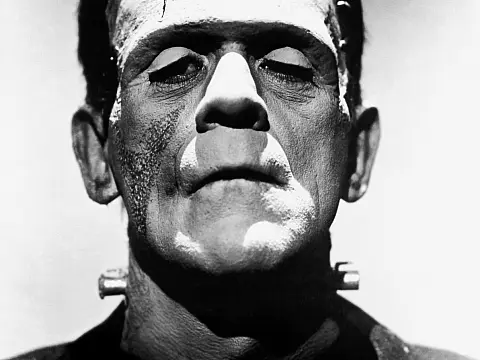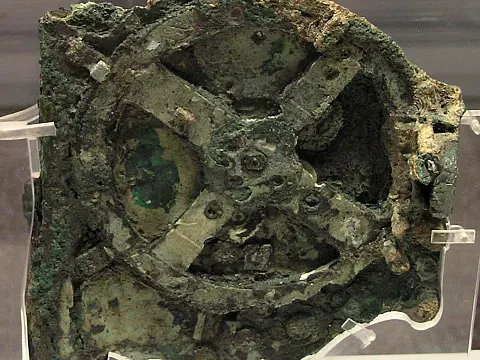The Science of HorrorWe take a look at the science of horror and some of the real life science behind the classical horror stories and films.
We all enjoy a good fright. Whether riding a roller coaster, bungee jumping or driving fast cars, a thirst for fright is in our nature. Some people are even thrill seekers who actively seek out scares and fear.
Psychologists call thrill-seekers T-types. They are those members of society most likely to indulge in adrenaline sports such as base jumping, extreme skiing and skydiving, and are most likely to jump on the scariest, most unsafe-looking rides at amusement parks. There are mixed benefits to being a T-type. These people have a desire to take risks, at least when exercised in moderation, and this can be a huge advantage in creative exploits. But there's also a downside. T-types are more likely to become involved in crime, drugs, and drunk driving and are statistically twice as likely to be involved in road accidents as they are constantly seeking the extra thrill.
Many people turn to horror fiction to get their fix of fright, preferring the terror produced by stimulating the imagination with the right choice of words or sequence of images. Some say horror fiction is perverse and even twisted. Conversely, others say an appreciation of it is in our best interests.
We fear death and dismemberment, we fear pain, insanity, and loss, we even fear sexuality, and it's only by addressing these fears that we avoid living in a constant state of trepidation. Clive Barker
Horror can speak of such things in a way that a more realistic or naturalistic genre can't. The human psyche isn't the only place where the myths of horror fiction stray within the boundaries of fact.
Frankenstein Surgery Unbound
Mary Wollstonecraft Shelley began work on Frankenstein, aka The Modern Prometheus, during a ghost story contest on the shore of Lake Geneva in June 1816. The concept of building creatures from recycled body parts has since been recycled by other authors, such as HP Lovecraft. The classic 1931 film adaptation of Frankenstein, starring Boris Karloff as the monster, has been copied many times.
Science is now bringing Baron Frankenstein's surgical experiments ever nearer to reality. In September 1998, surgeons in France succeeded in grafting a dead man's hand and lower arm to the arm of 48-year-old New Zealand businessman Clint Hallam. It was the world's first successful arm transplant. The 13-hour operation was possible because of new advances in immune suppressants, before which the patient's immune system had rejected the new limb. Surgeons are now predicting Face-Off style face transplants and even head transplants. In the 1970s, Dr Robert White transplanted the head of a monkey onto the body of another. He now believes he could perform the same operation on a human.
While cryogenic techniques allow organs to be perfectly preserved before surgery, repairing the damage caused by freezing remains the major stumbling block to Frankenstein-type scenarios.
The Science Behind Zombies
Zombies are human corpses that have been resurrected, albeit without any form of 'soul'. Zombies are one of the few classic horror denizens born directly to the screen without a preceding career in literature. They reached their peak with the 'Living Dead' film trilogy by George A. Romero.
The zombie is believed to have its origins in the drug rituals of Haiti's voodoo culture. A witch doctor first poisons his victim with a powerful toxin derived from puffer fish, containing the powerful poison tetrodotoxin. Instead of dying the victim is paralysed, falling into a deep coma and appearing dead.
After a couple of days, the witch doctor administers a hallucinogenic drug called Zombie's cucumber to revive the victim. If 'revive' is the appropriate word, that is. By this time, the original toxin will have caused severe brain damage, removing personality, memory, and speech and dulling the senses. The zombies created in this way are easy to control and are destined for 'lives' as menial slaves to their creator. Harvard ethnobotanist Wade Davis has investigated this theory. The unnerving account of Davis' research was made into a film by Wes Craven in his 1988 thriller The Serpent and the Rainbow.
Romanian Gothic
Bram Stoker's gothic masterpiece Dracula thrust vampires into the public imagination, where they have remained ever since. Dracula was a blend of Romanian history with Stoker's private nightmares and anxieties.
Dracula was believed to originate from Vladislav III in Romania, also known as Vlad the Impaler. Vlad III was the son of Vlad Dracul. Dracul is Romanian for Dragon. Dracula roughly translates as "Son of Dragon". Vlad Dracula was a particularly brutal and bloodthirsty ruler and it is believed that somewhere in translation bloodthirsty became drinking of blood.
Is there any scientific truth behind the condition of vampirism?
In 1985, chemist David Dolphin, of the University of British Columbia, suggested that historical vampires were victims of the disease porphyria. A genetic illness, it makes the skin extremely sensitive to sunlight and shrinks the gums, making the teeth appear elongated. It also turns sufferers' urine red, which could be misinterpreted as symptomatic of drinking blood.
Many vampire tales stem from the activities of the fifteenth-century Vlad the Impaler. However, he's not the only source. In the sixteenth century, Slovakian Countess Elizabeth Bathory tortured and killed 650 people throughout her life and bathed in their blood, which she believed was a cure for ageing. Elizabeth Bathory is probably the inspiration behind the many 'Bride of Dracula' movies.
Today, some self-proclaimed vampires claim to drink blood to feed and for sexual pleasure. Psychiatrists refer to this as haematomania. The Marquis de Sade and some serial killers have been cited as modern-day vampires and may have suffered from this condition.
Shapeshifters and Warewolves
Shapeshifter legends exist in many cultures around the world. Fictionally, tales of humans turning into savage beasts crop up as early as the thirteenth century, in Marie de France's Lay of the Bisclavet. Many legends describe werewolfism as a disease, called lycanthropy.
Scientists agree werewolf legends arose from cases of the nervous system disease rabies. A rabies sufferer foams at the mouth, so resembling an angry animal, and will often vomit blood. In some cases, rabies victims will enter a violent frenzy, attacking and biting other people. Rabies is transmitted by a virus which can be contracted from a bite so this offers one explanation of the belief that those surviving a werewolf attack become werewolves themselves.
Psychos and Serial Killers
Norman Bates missed his mum; other psychos hate theirs. Psychosis is defined as a serious psychological disturbance, incorporating 5 symptoms of hallucinations, delusions, paranoia, and schizophrenia. Sufferers can be violent killers and so it's not surprising then that some of horror's lead villains have been psychopaths.
Robert Bloch's 1959 novel Psycho was turned into a famous movie by Alfred Hitchcock a year later. Both were based on Wisconsin serial killer Ed Gein. When Gein was arrested in the winter of 1957 police found hordes of preserved human body parts littering his house. Gein was declared insane and committed to the Mendota Mental Health Institute, where he died on 26 July 1984, of respiratory failure. The subgenre that Psycho initiated has produced further classics, including Halloween and Silence of the Lambs.
What makes psychos and serial killers tick? Psychiatrists believe that killers do the things they do to make up for emotional and social deficiencies in their lives, such as being abused during childhood. When the violence fails to ease the pain, they think they must have got something wrong and so kill again. And again, and again...
See Igor, It lives!
The ability of mad scientists to strike terror into our hearts has been exploited throughout much of horror. Some say scientists are the modern embodiment of our traditional fear of shamans and witch doctors - mysterious, solitary figures, possessing powers that for most of us are unfathomable, says Glenn Scott Allen of Towson University, Baltimore. And just as witches were the scapegoats for the problems of medieval society, so scientists, and engineers, have come to bear the brunt of public blame for many of the world's problems, for instance, global warming.
Additionally, nuclear accidents and toxic waste leaks form prominent real-world examples of the 'science running amuck' theme explored by many horror movies.
Scientists' appearance is everything to the public. Take the dispute between Robert Oppenheimer and Edward Teller over whether to develop the hydrogen bomb after World War II. Oppenheimer opposed Teller's avocation of the project. Because Oppenheimer's appearance fitted the mad-scientist stereotype, whilst Teller came over as a kindly, helping figure, the H-bomb project got approval. Despite his genial demeanour, Teller was later the inspiration for Stanley Kubrick's 1964 film Dr Strangelove.
Perhaps the most inventive mad scientists in fiction can be found in the films of David Cronenberg, whose creations include aphrodisiacs that carry VD and a television signal that gives perverts brain tumours.
Science behind Mummies and Curses
In late December 1922, Lord Carnarvon and archaeologist Howard Carter broke through into the tomb of Tutankhamun. On 5 April 1923, Lord Carnarvon died. Rumours immediately began to circulate about The curse of Tutankhamen, planted in the tomb by the Egyptian priests in 1323BC, where it lay waiting for the person who would be first to defile the boy pharaoh's grave.
"Tutmania" seized the world. Many authors, including Agatha Christie, rushed 'their Egypt-related works to the stage, and by 1932 the first mummy film, Karl Freund's The Mummy, starring Boris Karloff, had hit the silver screen. While many others have followed, Arthur Conan Doyle beat the hype with his 1890 mummy novel The Ring of Thoth, on which many of the modern mummy tales are based.
Most archaeologists don't buy the King Tut curse story, suspecting that Lord Carnarvon died from an infected mosquito bite. Recently, a French scientist even suggested that Carnarvon died from a virulent strain of the virus which had been lurking in the tomb for 3,000 years.
Physically Deformed
The deformed and the disfigured can be both the most endearing and the most hateful of horror characters. The most famous is Quasimodo from The Hunchback of Notre Dame, based on Victor Hugo's 1831 novel Notre-Dame de Paris, about a deformed bell-ringer who falls in love with a gipsy girl.
Hunchback, an extreme curvature of the upper spine, is a well-known deformity. It's caused by one of two conditions: kyphosis, excessive rearward spinal curvature, or scoliosis, a sideways curvature. David Lynch's 1980 film The Elephant Man chronicles the true and painful story of the horribly disfigured John Merrick. However, it wasn't the flesh-swelling 'Elephant Man disease' that Merrick suffered from, but a much rarer condition, called Proteus Syndrome, which causes overgrowth of bone and other tissue.
Birth defects came to the fore with the drug thalidomide, prescribed to pregnant women in the late 1950s to alleviate the symptoms of morning sickness. However, the drug was found to produce malformations in babies, like missing arms and legs. Recently, the spermicide chemical nonoxinol-9 was linked with birth deformities.


















